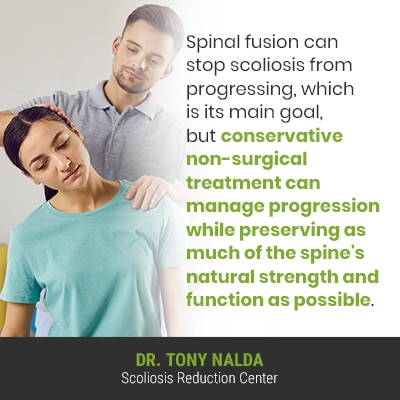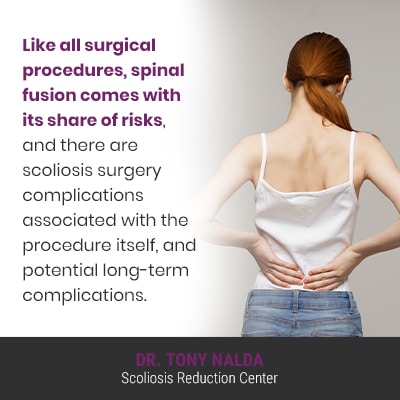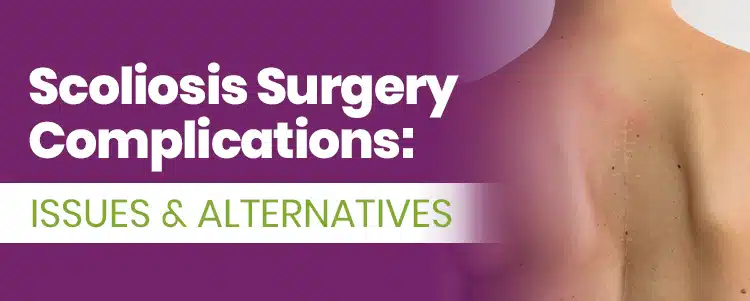The most important decision a patient has to make is how to respond, with treatment, to a scoliosis diagnosis; different scoliosis treatment approaches affect spinal health and function differently. From a surgical to a non-surgical treatment response, how the spine responds to treatment depends on a number of factors such as patient age, treatment type, condition type, and severity.
Scoliosis surgery is a type of spinal fusion, and like all surgical procedures, it comes with potential risks, side effects, and complications, so should be considered carefully. The reality is that not all cases of scoliosis require surgery, and there is also non-surgical treatment to consider.
Before getting to the specifics of scoliosis surgery, let’s start with how scoliosis affects the body.
How Scoliosis Affects the Body
A diagnosis of scoliosis means an unnatural sideways spinal curve, with rotation, has developed, and in addition to bending unnaturally to the side, the scoliotic spine also twists, and this rotational component makes scoliosis a complex 3-dimensional condition.
As scoliosis develops, the spine and its surrounding muscles and nerves are being exposed to uneven forces, as is the entire body, and this is why scoliosis can affect the body in a number of ways.
Those uneven forces can affect the body in a number of ways, and remember, the spine doesn’t just allow us to stand upright, practice good posture, and move flexibly, the spinal cord within also works in tandem with the brain to form the body’s central nervous system (CNS).
The central nervous system is a complex and vast communication network that facilitates brain-body communication, so the spine is involved in the function of virtually every working part and system within the body.
No two cases of scoliosis are the same, which is why treatment plans need to be fully customized to address key patient/condition variables: patient age, condition type, severity, and curvature location.
Scoliosis also ranges widely in severity from mild to moderate and severe to very severe, and the condition’s severity levels are also the condition’s progressive line.
A scoliosis diagnosis also means being diagnosed with a progressive condition, and with progressive conditions like scoliosis, the best time to start treatment is always now.
Scoliosis is Progressive
One of the most important condition characteristics to understand is that scoliosis is a progressive condition, meaning its nature is to get worse over time, which is why how a diagnosis is responded, or not responded to, can have far-reaching effects.
Virtually all cases of scoliosis will progress at some point; only proactive treatment can work towards counteracting the condition’s progressive nature.
While we don’t understand what triggers the initial onset of scoliosis in most cases, we do know what triggers its progression: growth and development.
So where a scoliosis is at the time of diagnosis isn’t indicative of where it will stay, and scoliosis progressing means the size of the unnatural spinal curve is increasing, and as this happens, the condition’s uneven forces are increasing, as are their effects.
In addition, as scoliosis progresses, it gets increasingly complex to treat; as a scoliotic curve gets larger, the spine gets more rigid, making it less responsive to treatment, and as condition effects increase with progression, the body is more and more affected.
It’s far more effective to proactively work towards preventing progression and increasing condition-effects, than it is to attempt to work towards reversing those effects once they’re established; the longer scoliosis is left untreated, the more complex it’s going to be to treat.
While there are no treatment guarantees, with scoliosis that’s detected and treated early in its progressive line, there are fewer limits to what can be achieved.
In children, the main effect of scoliosis is postural deviation, which will become more noticeable as progression occurs, and in adults, the main symptom of scoliosis is pain, and this is because scoliosis becomes a compressive condition in adulthood after skeletal maturity has been reached.
With progressive conditions like scoliosis, sometimes when treatment is started is almost as important as the type of treatment started, so let’s now address the difference between a surgical and non-surgical scoliosis treatment response.
Scoliosis Surgery
Scoliosis surgery is a type of spinal fusion that involves fusing the curve’s most-tilted vertebrae into one solid bone and attaching rods with screws to the spine to hold it in place.

Like all surgical procedures, spinal fusion comes with its share of risks, and there are scoliosis surgery complications associated with the procedure itself, and potential long-term complications.
Potential complications associated with the surgery itself include:
- Nerve damage
- Infection
- Excessive blood loss
- Adverse reaction to hardware used
Potential long-term complications can include:
- Reduced range of motion
- Reduced spinal flexibility
- Pain at the fusion site
- Hardware malfunction over time
- The need for subsequent surgeries
- Living with a spine that’s weaker and more vulnerable to injury
A spine that’s fused is contrary to its movement-based design, so addressing scoliosis surgically can cost the spine in terms of its overall health, strength, and function.
Spinal fusion can stop scoliosis from progressing, which is its main goal, but conservative non-surgical treatment can manage progression while preserving as much of the spine’s natural strength and function as possible.
Conservative Non-Surgical Scoliosis Treatment
Here at the Scoliosis Reduction Center®, I treat my patient with a conservative non-surgical chiropractic-centered treatment approach that is less costly, invasive, and doesn’t carry the same heavy potential complications that come with spinal fusion.

A conservative treatment approach integrates multiple different types of treatment that complement one another and can impact conditions on every level.
As a structural spinal condition, scoliosis has to, first and foremost, be impacted on a structural level, and I work towards this through chiropractic care and a curvature reduction.
Through a series of technique and manual adjustments, I can work towards adjusting the position of the curve’s most-tilted vertebrae back into alignment with the rest of the spine.
Once I start to see structural results, I can shift the focus to increasing core strength through physical therapy so the spine’s surrounding muscles are strong and can provide it with optimal support.
Physical therapy can also help improve posture, address any related muscle imbalance, and certain scoliosis-specific exercises (SSEs) can help activate specific areas of the brain for improved brain-body communication.
Corrective bracing can be particularly effective on growing spines so is commonly used as a facet of treatment in the condition’s most-prevalent type: adolescent idiopathic scoliosis, diagnosed between the ages of 10 and 18.
The final and ongoing stage of treatment is rehabilitation, and this involves a series of custom-prescribed exercises to further stabilize and heal the spine from home.
Conclusion
While surgeons have their patients’ best interests at heart, when a procedure comes with the serious potential risks, side effects, and complications that spinal fusion does, it should be considered carefully.
Fortunately, for those who choose to forgo a surgical recommendation, or those who simply want to try a less-invasive treatment option first, there is a non-surgical treatment option with proven results.
Traditional scoliosis treatment tends to funnel patients towards spinal fusion, quite simply, because it doesn’t have a strategy for treating scoliosis while mild, so does little to prevent progression, and instead reacts with surgery when/if a patient’s scoliosis becomes severe.
Spinal fusion is a costly, invasive, and risky procedure, and there is a gap in the long-term research on the effects of living with a spine 20, 30, 40+ years after surgery, but one thing we know is that a fused spine is not as strong and is more vulnerable to injury.
In addition, many patients are disappointed with the reduced range of motion and spinal flexibility they’re left with, and as is the case with all types of treatment, there are never treatment guarantees.
Scoliosis surgery failure can mean the scoliosis continues to progress, the fusion is unsuccessful and subsequent surgeries are needed, and/or there is a hardware malfunction such as a rod breaking or a screw coming loose.
For those interested in a non-surgical treatment alternative, there is a conservative chiropractic-centered treatment approach that benefits from the application of multiple types of scoliosis-specific treatment disciplines so conditions can be impacted on every level.
The risks and potential complications are low with conservative treatment because we are working towards corrective results, meaning a structural curvature reduction and increased core strength so the spine’s surrounding muscle can optimally support the spine, and the treatment applied is aligned with the spine’s movement-based design.
If you, or someone you are about, is interested in a modern conservative treatment approach that preserves as much of the spine’s natural strength and function as possible, don’t hesitate to reach out to us here at the Center.




